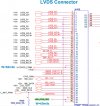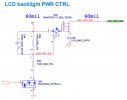I couldn't decide whether to start a separate topic, but decided against since what I'm about to ask about is still tied directly to this machine and replacing the screen.
If you refer back to the initial post in this topic, you will see that the original screen break caused a black band, vertically, on the right hand side of the screen.
I received my replacement of the defective replacement screen two days ago, and decided to put it in today. The install itself has gone smoothly and the screen seems to be functioning correctly, but I'm seeing something I have never, ever seen before and it so happens to be situated on the screen where that black band was when it was originally brought to me.
Note in these two photos that there is what looks like a B7 or 87, in tiny orange dots, showing on the screen. It is there constantly, and the one screen shot shows it floating over top of the desktop wallpaper, and the second over part of a Windows Settings dialog when it's moved to the position on the screen where this thing lives:


Before I contact either the folks at laptopscreen.com or the client, I wanted to check to see if this "looks familiar" to anyone else. I've touched absolutely nothing related to screen settings, programs, etc., other than uninstalling a just-expired trial of McAfee and letting Windows Security take over.
And on restarting, it is definitely showing on the Windows lock screen, so I'm at a real loss here.
This is an "entirely new one" for me, and I have absolutely no idea of what may be causing it or what to do next.




